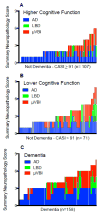Clinical-pathologic correlations in vascular cognitive impairment and dementia
- PMID: 26319420
- PMCID: PMC4769968
- DOI: 10.1016/j.bbadis.2015.08.019
Clinical-pathologic correlations in vascular cognitive impairment and dementia
Abstract
The most common causes of cognitive impairment and dementia are Alzheimer's disease (AD) and vascular brain injury (VBI), either independently, in combination, or in conjunction with other neurodegenerative disorders. The contribution of VBI to cognitive impairment and dementia, particularly in the context of AD pathology, has been examined extensively yet remains difficult to characterize due to conflicting results. Describing the relative contribution and mechanisms of VBI in dementia is important because of the profound impact of dementia on individuals, caregivers, families, and society, particularly the stability of health care systems with the rapidly increasing age of our population. Here we discuss relationships between pathologic processes of VBI and clinical expression of dementia, specific subtypes of VBI including microvascular brain injury, and what is currently known regarding contributions of VBI to the development and pathogenesis of the dementia syndrome. This article is part of a Special Issue entitled: Vascular Contributions to Cognitive Impairment and Dementia edited by M. Paul Murphy, Roderick A. Corriveau and Donna M. Wilcock.
Copyright © 2015 Elsevier B.V. All rights reserved.
Figures



References
-
- Knopman DS, Petersen RC, Edland SD, et al. The incidence of frontotemporal lobar degeneration in Rochester, Minnesota, 1990 through 1994. Neurology. 2004;62:506–8. - PubMed
-
- Mercy L, Hodges JR, Dawson K, et al. Incidence of early-onset dementias in Cambridgeshire, United Kingdom. Neurology. 2008;71:1496–9. - PubMed
-
- Borroni B, Alberici A, Grassi M, et al. Prevalence and demographic features of early-onset neurodegenerative dementia in Brescia County, Italy. Alzheimer Dis Assoc Disord. 2011;25:341–4. - PubMed
Publication types
MeSH terms
Grants and funding
LinkOut - more resources
Full Text Sources
Other Literature Sources

